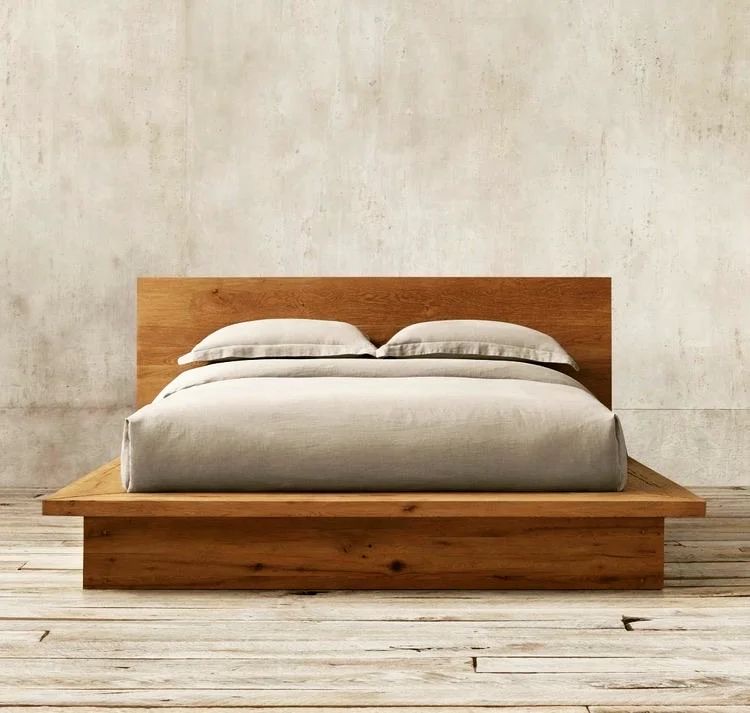Best Wood for Bed Frames
Ever wondered what makes the perfect wood for your bed frame, combining both beauty and durability?
In a Nutshell:
The best wood for bed frames includes options like Douglas Fir, Mahogany, Walnut, Khaya, Oak, Poplar, Padauk, Pine, Alder, Sapele, and Cherry. Each wood type offers a unique blend of durability, resistance to decay, and aesthetic appeal. For instance, Douglas Fir is strong yet adaptable, Mahogany is luxurious with flexible density, and Oak offers excellent stability. These woods vary in hardness, color, and grain patterns, allowing you to choose based on your aesthetic preference and functional requirements. The choice of wood significantly impacts the bed frame’s longevity, strength, and overall appearance.
Lumber for Wooden Bed Frames
1 | Douglas Fir
Despite being a softwood, Douglas fir can make a great choice when it comes to building or buying a bed frame. It is denser than several other kinds of softwood and can offer a good amount of sturdiness and balance to the frame, making it safe to use.
Additionally, Douglas fir comes with a Janka hardness rating of 620 lbf (or pounds-force). This can make it possible for the wood to showcase plenty of adaptability and workability in case you want to try making the bed frame by yourself. Douglas fir has a light brown or yellowish color along with several streaks of dark red.
| Wood Characteristics | Douglas Fir for Bed Frame Details |
|---|---|
| Wood Type | Softwood (Douglas Fir Tree) |
| Scientific Name | Pseudotsuga menziesii |
| Wood Grain | Straight and uniform |
| Wood Density (lb/ft³, N/m³) | 32 lb/ft³ (513 kg/m³) |
| Wood Janka Scale | 660 lbf (pound-force) |
| Wood Stability | Fairly stable, with moderate resistance to warping and shrinking |
| Wood Finish | Accepts stains and finishes well; also suitable for painting |
| Wood Sustainability | Often available from sustainably managed forests; look for FSC certification |
| Wood Cost | Affordable compared to hardwoods, slightly more expensive than other softwoods |
| Moisture Content | 12-15% (kiln-dried) |
| Shrinkage | R: 2.5%, T: 5.0%, V: 7.5%, T/R Ratio: 2.0 |
| Average Dried Weight (lb/ft³, kg/m³) | 32 lbs/ft³ (513 kg/m³) |
| Build vs Buy Cost | |
| DIY Bed Frame Cost | $300 – $600 (varies depending on materials, tools, and design complexity) |
| Store-Bought Cost | $800 – $2,000 (varies depending on brand, materials, and design) |
Douglas Fir: Mini-Summary & Ideal Bed Frame Type
- Ideal Bed Frame Type: Choose a simple yet strong design for a Douglas Fir bed frame, taking advantage of its excellent strength-to-weight ratio and stability.
- Finishing Options: Enhance the Douglas Fir’s natural appearance with stains or finishes, or paint it to complement your bedroom’s color scheme.
- Features & Benefits: Douglas Fir offers affordability, good stability, and moderate density, making it an excellent choice for a durable and cost-effective bed frame.
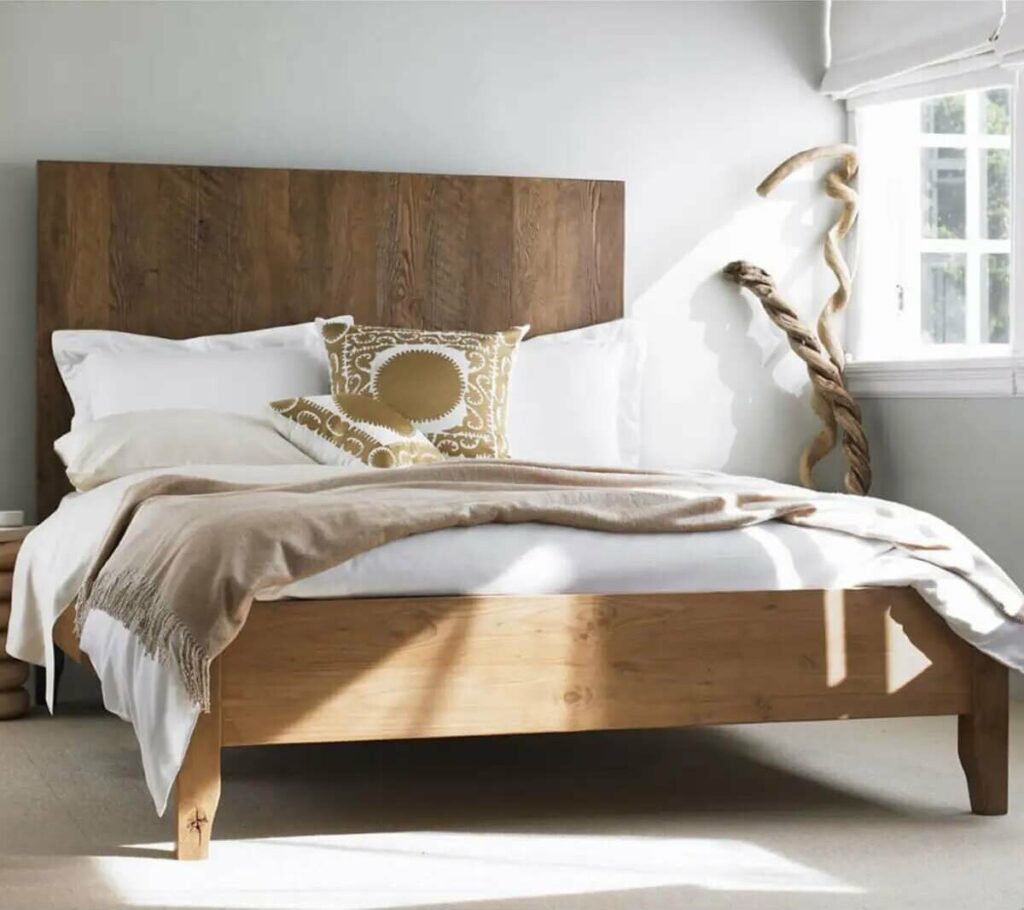
Pros
Cons
2 | Mahogany
Mahogany is a hardwood that ranks differently in terms of its density level. This is because there are numerous species of mahogany, although the overall hardness is such that you can get a reliable combination of both stability and flexibility.
Mahogany generally has a dark color, like deep red or brown, although it can look quite pale or light initially. Its grain structure and patterns tend to be a bit loose and usually result in interesting appearances. This kind of wood is also extremely convenient to work with due to its readiness to take sanding, paints, stains, and finishes.
| Wood Characteristics | Mahogany for Bed Frame Details |
|---|---|
| Wood Type | Hardwood (Mahogany Tree) |
| Scientific Name | Swietenia macrophylla |
| Wood Grain | Straight to interlocked, with a medium to coarse texture |
| Wood Density (lb/ft³, N/m³) | 34 – 53 lb/ft³ (545 – 850 kg/m³) |
| Wood Janka Scale | 800 – 1,200 lbf (pound-force) |
| Wood Stability | Stable, with good resistance to warping and shrinking |
| Wood Finish | Takes stains and finishes well; also suitable for painting |
| Wood Sustainability | May vary depending on the source; look for FSC certification or other sustainable certifications |
| Wood Cost | Expensive compared to softwoods and some hardwoods |
| Moisture Content | 8-12% (kiln-dried) |
| Shrinkage | R: 2.9%, T: 4.3%, V: 7.2%, T/R Ratio: 1.48 |
| Average Dried Weight (lb/ft³, kg/m³) | 34 – 53 lbs/ft³ (545 – 850 kg/m³) |
| Build vs Buy Cost | |
| DIY Bed Frame Cost | $600 – $1,200 (varies depending on materials, tools, and design complexity) |
| Store-Bought Cost | $1,500 – $4,000 (varies depending on brand, materials, and design) |
Mahogany: Mini-Summary & Ideal Bed Frame Type
- Ideal Bed Frame Type: Opt for an elegant and luxurious design for a Mahogany bed frame, capitalizing on its rich color, distinctive grain pattern, and high-end appeal.
- Finishing Options: Showcase Mahogany’s natural beauty with clear finishes or oils that enhance its reddish-brown hue and fine texture, or use a compatible stain to achieve a desired shade.
- Features & Benefits: Mahogany is prized for its durability, dimensional stability, and resistance to decay, making it an ideal choice for a long-lasting and visually stunning bed frame.
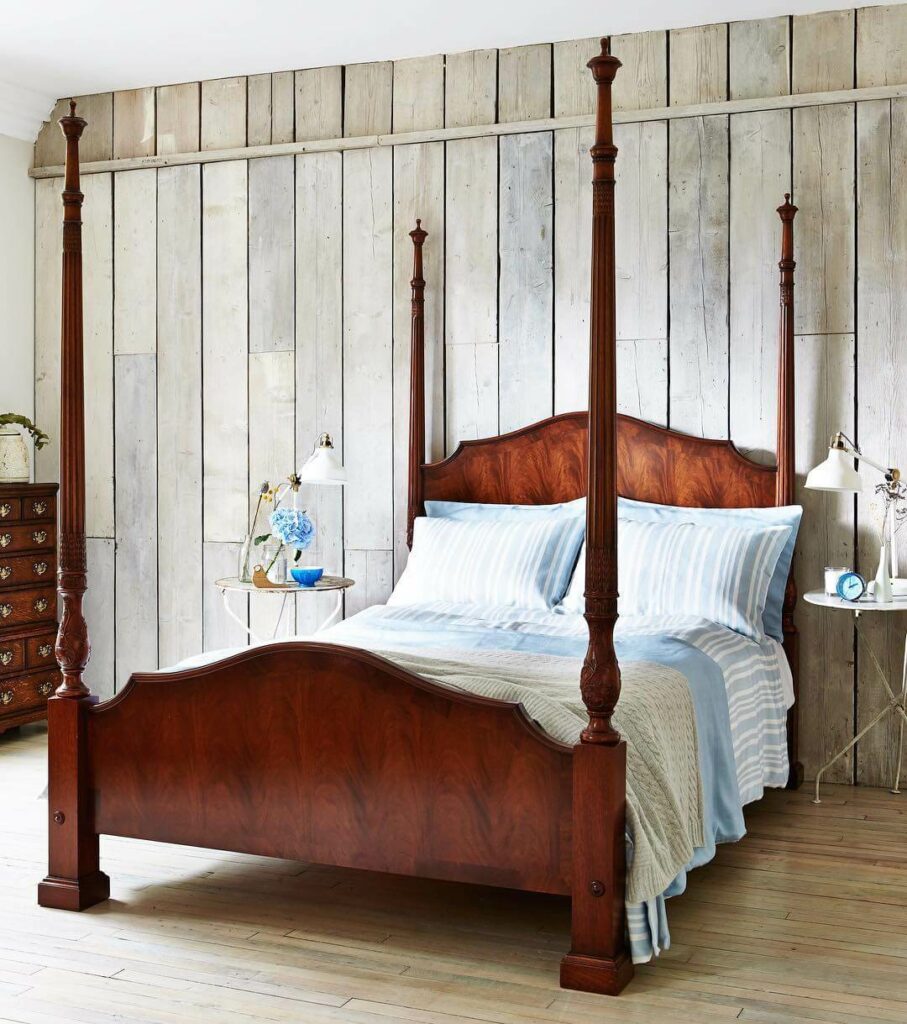
Pros
Cons
3 | Walnut
Walnut is a kind of wood that can offer high levels of stability and durability. It measures 10,10 lbf on the Janka scale, making it an ideal choice for sturdiness as well as protection against damage.
This wood is distinct and special because it has several color varieties that can lend a lovely appearance to your bed frame. These colors include golden brown, chocolate, and coconut, with the grain patterns often exhibiting their own multitude of colors too. Walnut wood also responds well to woodworking tools and finishes in case you want to structure the frame on your own.
| Wood Characteristics | Walnut for Bed Frame Details |
|---|---|
| Wood Type | Hardwood (Walnut Tree) |
| Scientific Name | Juglans nigra |
| Wood Grain | Straight to wavy or irregular, with a medium to coarse texture |
| Wood Density (lb/ft³, N/m³) | 38 lb/ft³ (609 kg/m³) |
| Wood Janka Scale | 1,010 lbf (pound-force) |
| Wood Stability | Stable, with good resistance to warping and shrinking |
| Wood Finish | Takes stains and finishes well; also suitable for painting |
| Wood Sustainability | May vary depending on the source; look for FSC certification or other sustainable certifications |
| Wood Cost | Expensive compared to softwoods and some hardwoods |
| Moisture Content | 8-12% (kiln-dried) |
| Shrinkage | R: 5.5%, T: 7.8%, V: 13.3%, T/R Ratio: 1.42 |
| Average Dried Weight (lb/ft³, kg/m³) | 38 lbs/ft³ (609 kg/m³) |
| Build vs Buy Cost | |
| DIY Bed Frame Cost | $800 – $1,500 (varies depending on materials, tools, and design complexity) |
| Store-Bought Cost | $2,000 – $5,000 (varies depending on brand, materials, and design) |
Walnut: Mini-Summary & Ideal Bed Frame Type
- Ideal Bed Frame Type: Choose a sophisticated and timeless design for a Walnut bed frame, emphasizing its rich, dark color, and smooth grain pattern for a contemporary and elegant look.
- Finishing Options: Apply clear finishes or oils to enhance Walnut’s natural chocolate-brown color and accentuate its unique grain, or opt for darker stains to create a more luxurious appearance.
- Features & Benefits: Walnut boasts exceptional strength, durability, and resistance to wear, ensuring a durable and high-quality bed frame that will remain a statement piece in your bedroom.
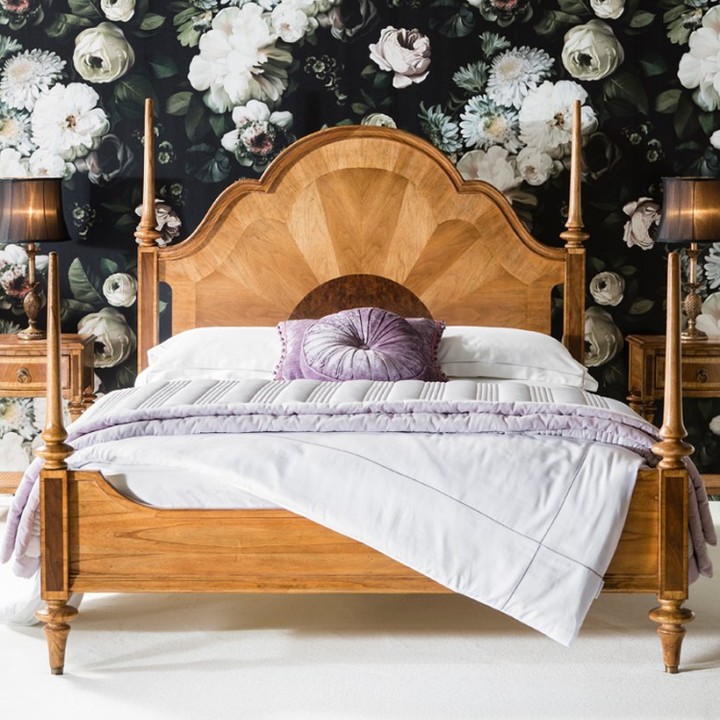
Pros
Cons
4 | Khaya
Technically, Khaya belongs to the mahogany family but tends to differ from it to a certain extent. It is also referred to as African mahogany and can act as a valuable and affordable substitute for standard mahogany wood.
Khaya wood comes with a pale pink to darker red-brown color, which is probable to become deeper and richer as time passes. This can help preserve the identity and appearance of the wood that you use for your bed frame. It also has many streaks of darker colors. This wood also has natural oil content that can add a natural shine and a degree of protection from moisture and varying water levels.
| Wood Characteristics | Khaya for Bed Frame Details |
|---|---|
| Wood Type | Hardwood (Khaya Tree) |
| Scientific Name | Khaya spp. (Khaya ivorensis, Khaya senegalensis, etc.) |
| Wood Grain | Straight to interlocked, with a moderately coarse texture |
| Wood Density (lb/ft³, N/m³) | 35 lb/ft³ (561 kg/m³) |
| Wood Janka Scale | 990 lbf (pound-force) |
| Wood Stability | Moderately stable, with moderate resistance to warping and shrinking |
| Wood Finish | Accepts stains and finishes well; also suitable for painting |
| Wood Sustainability | May vary depending on the source; look for FSC certification or other sustainable certifications |
| Wood Cost | Moderate to expensive, depending on the specific Khaya species and availability |
| Moisture Content | 8-12% (kiln-dried) |
| Shrinkage | R: 4.1%, T: 6.3%, V: 10.4%, T/R Ratio: 1.54 |
| Average Dried Weight (lb/ft³, kg/m³) | 35 lbs/ft³ (561 kg/m³) |
| Build vs Buy Cost | |
| DIY Bed Frame Cost | $600 – $1,200 (varies depending on materials, tools, and design complexity) |
| Store-Bought Cost | $1,500 – $4,000 (varies depending on brand, materials, and design) |
Khaya: Mini-Summary & Ideal Bed Frame Type
- Ideal Bed Frame Type: Opt for a traditional or contemporary design for a Khaya bed frame, capitalizing on its warm reddish-brown color and interlocked grain for a visually appealing and cozy atmosphere.
- Finishing Options: Use clear finishes, oils, or stains to emphasize Khaya’s natural color and grain, or experiment with darker shades to achieve a richer, more luxurious look resembling genuine mahogany.
- Features & Benefits: Khaya provides a cost-effective alternative to genuine mahogany, offering similar aesthetics and workability while still delivering a reliable and sturdy bed frame for years to come.
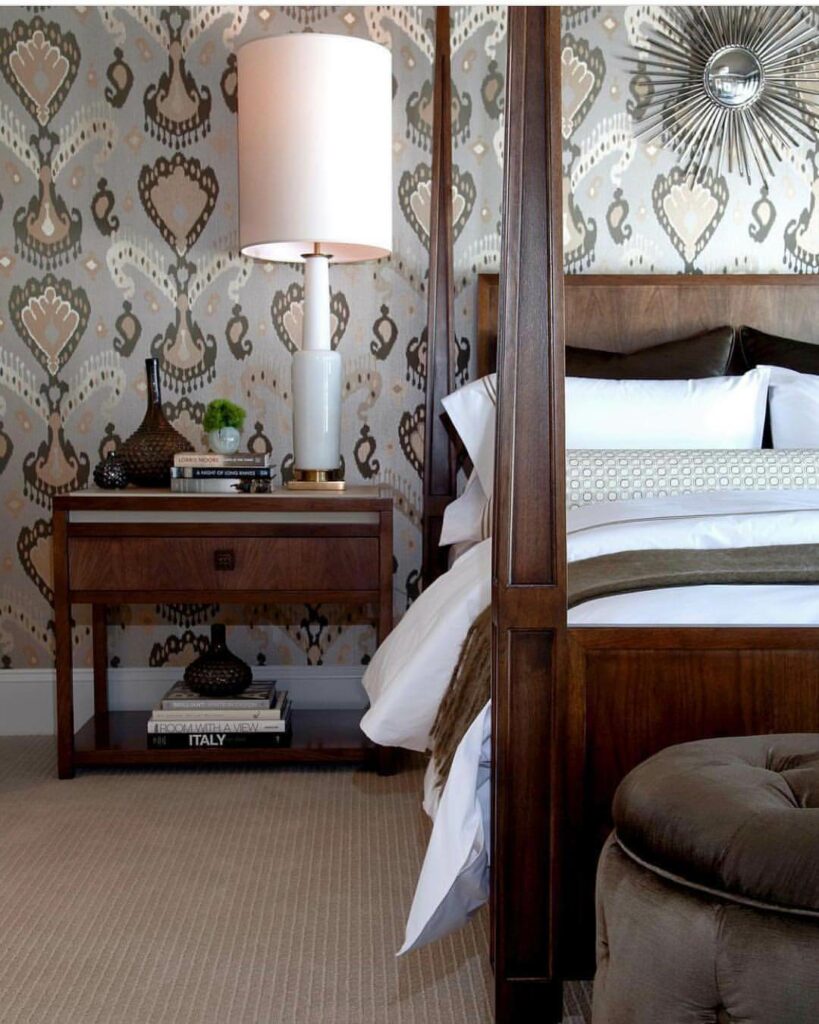
Pros
Cons
5 | Oak
Oak, as the name suggests, comes from oak trees. Oak is a highly popular hardwood used for building, construction as well as smaller woodworking projects. There are numerous varieties of oak, with white and red oak being particularly common.
These usually differ from each other based on their hardness, with white oak having a 1,350 lbf rating and red oak measuring 1,220 lbf. Given this difference in variety, you can also obtain oakwood in multiple colors, such as multiple shades of brown and red, along with occasional yellow, red and olive patterns on the grain.
| Wood Characteristics | Oak for Bed Frame Details |
|---|---|
| Wood Type | Hardwood (Oak Tree) |
| Scientific Name | Quercus spp. (Quercus alba, Quercus robur, etc.) |
| Wood Grain | Straight, with a coarse and uneven texture |
| Wood Density (lb/ft³, N/m³) | 44 lb/ft³ (705 kg/m³) |
| Wood Janka Scale | 1,350 lbf (pound-force) for White Oak, 1,120 lbf for Red Oak |
| Wood Stability | Good stability, with good resistance to warping and shrinking |
| Wood Finish | Accepts stains and finishes well; also suitable for painting |
| Wood Sustainability | Generally available from sustainably managed forests; look for FSC certification |
| Wood Cost | Moderate to expensive, depending on the specific Oak species and availability |
| Moisture Content | 6-8% (kiln-dried) |
| Shrinkage | R: 4.2%, T: 8.6%, V: 12.8%, T/R Ratio: 2.04 (White Oak) |
| Average Dried Weight (lb/ft³, kg/m³) | 44 lbs/ft³ (705 kg/m³) (White Oak), 48 lbs/ft³ (770 kg/m³) (Red Oak) |
| Build vs Buy Cost | |
| DIY Bed Frame Cost | $400 – $800 (varies depending on materials, tools, and design complexity) |
| Store-Bought Cost | $1,200 – $3,500 (varies depending on brand, materials, and design) |
Oak: Mini-Summary & Ideal Bed Frame Type
- Ideal Bed Frame Type: Oakwood is well-suited for traditional, rustic, or modern bed frame designs, with its distinctive grain patterns and strength providing both visual appeal and durability.
- Finishing Options: Choose from a variety of clear finishes, stains, or oils to enhance oakwood’s natural color and grain, or opt for a whitewashed or limed finish for a contemporary or coastal aesthetic.
- Features & Benefits: Oak boasts a combination of strength, durability, and attractive grain patterns, making it a popular choice for long-lasting, visually appealing bed frames that can withstand the test of time.
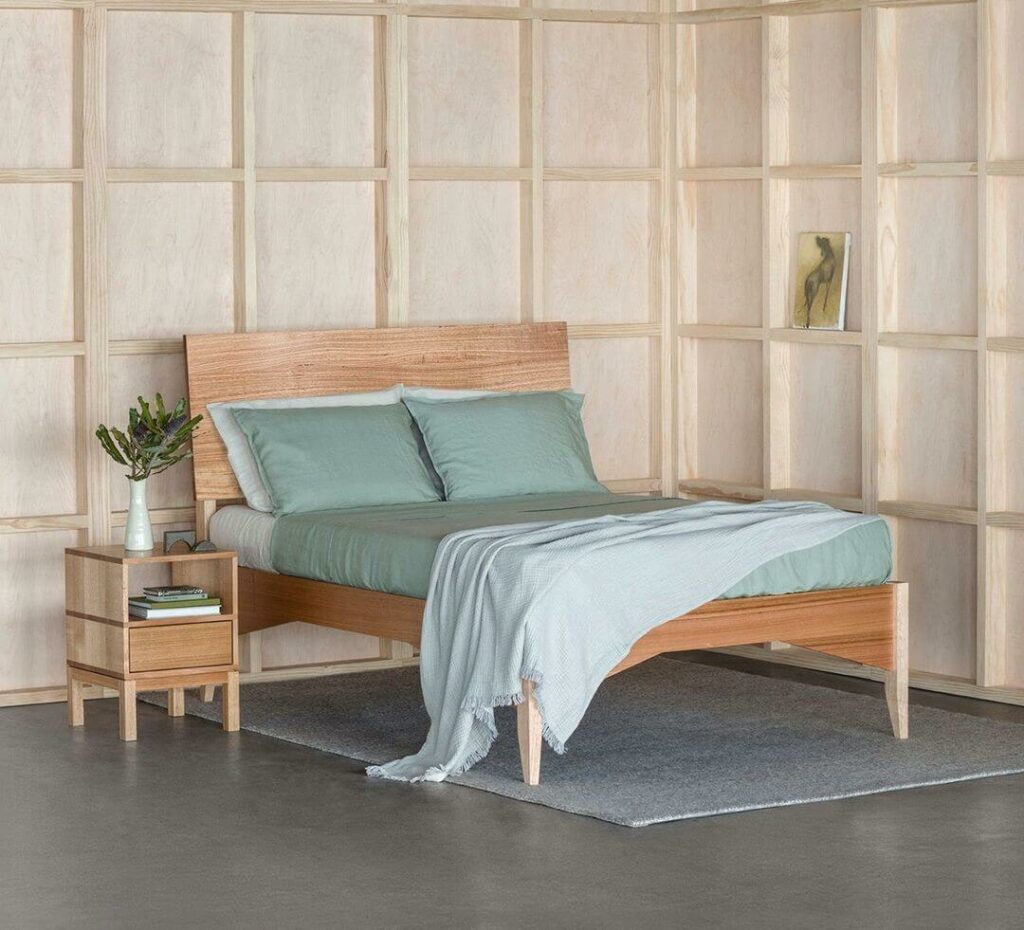
Pros
Cons
6 | Poplar
Poplar wood can be a suitable choice for bed frames and is, in fact, highly common in this kind of usage. Despite being a hardwood, poplar actually ranks quite low on the Janka scale in terms of its overall density, with different varieties measuring around 500 lbf.
Despite this, poplar is still quite sturdy and durable and can hold up well for a long period of time, resisting multiple forms of exposure to decay and rot. Poplar wood is available in colors like cream, white, pale yellow or even a slightly darker brown. Additionally, it has closed-grain patterns with small pores and generally provides a uniform texture that can make it adaptable and workable.
| Wood Characteristics | Poplar for Bed Frame Details |
|---|---|
| Wood Type | Softwood (Poplar Tree) |
| Scientific Name | Populus spp. (Populus tremuloides, Populus grandidentata, etc.) |
| Wood Grain | Straight, with a fine and even texture |
| Wood Density (lb/ft³, N/m³) | 24 lb/ft³ (385 kg/m³) |
| Wood Janka Scale | 540 lbf (pound-force) |
| Wood Stability | Fair stability, with moderate resistance to warping and shrinking |
| Wood Finish | Accepts stains and finishes well; also suitable for painting |
| Wood Sustainability | Generally available from sustainably managed forests; look for FSC certification |
| Wood Cost | Inexpensive compared to hardwoods |
| Moisture Content | 6-8% (kiln-dried) |
| Shrinkage | R: 4.9%, T: 8.1%, V: 13.0%, T/R Ratio: 1.65 |
| Average Dried Weight (lb/ft³, kg/m³) | 24 lbs/ft³ (385 kg/m³) |
| Build vs Buy Cost | |
| DIY Bed Frame Cost | $200 – $400 (varies depending on materials, tools, and design complexity) |
| Store-Bought Cost | $500 – $1,500 (varies depending on brand, materials, and design) |
Poplar: Mini-Summary & Ideal Bed Frame Type
- Ideal Bed Frame Type: Poplar is an excellent choice for minimalist or painted bed frame designs, as its light color and subdued grain allow for a wide range of finishing options and styles.
- Finishing Options: Poplar takes paint exceptionally well, making it perfect for a painted bed frame; it can also be stained or finished with clear coats to showcase its subtle wood grain.
- Features & Benefits: Poplar wood is affordable, lightweight, and easy to work with, making it an attractive option for DIY bed frame projects where cost-effectiveness and ease of handling are essential.
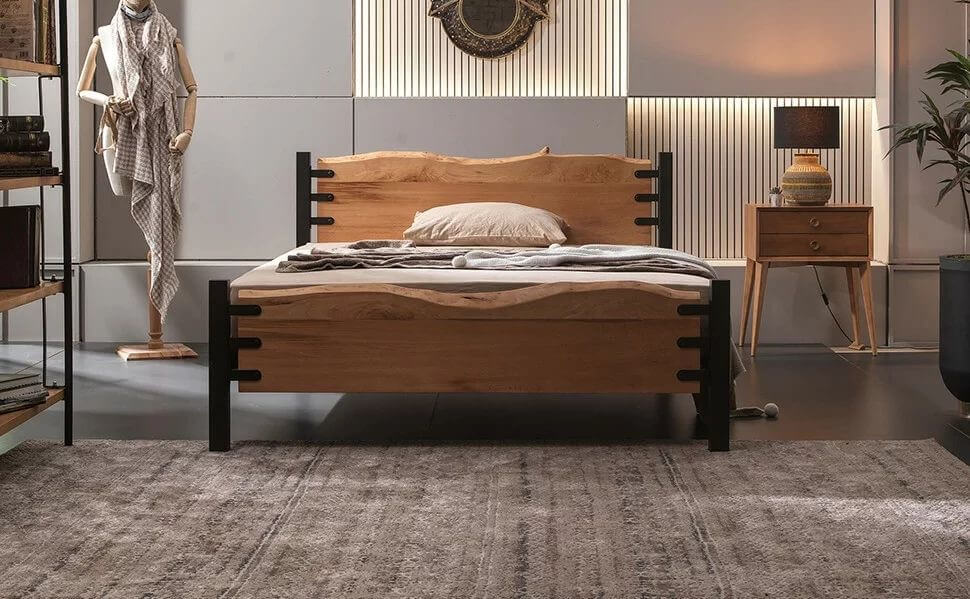
Pros
Cons
7 | Maple
Maple is a hardwood that has high levels of density, measuring a whopping 1,450 lbf on the Janka scale of hardness. This can make this wood a fine choice for your bed frame, considering that it can hold up well in a variety of conditions over a long span of time.
Maple can be of multiple varieties, with each of them exhibiting differences in terms of color and grain structures. The color, for instance, ranges from a light pink-orange to a richer and darker reddish-brown, usually darkening over time. The grains are also quite open with a coarse texture.
| Wood Characteristics | Maple for Bed Frame Details |
|---|---|
| Wood Type | Hardwood (Maple Tree) |
| Scientific Name | Acer spp. (Acer saccharum, Acer rubrum, etc.) |
| Wood Grain | Straight or wavy, with a fine and even texture |
| Wood Density (lb/ft³, N/m³) | 44 lb/ft³ (705 kg/m³) |
| Wood Janka Scale | 1450 lbf (pound-force) |
| Wood Stability | Good stability, with high resistance to warping and shrinking |
| Wood Finish | Accepts stains and finishes well; also suitable for painting |
| Wood Sustainability | Generally available from sustainably managed forests; look for FSC certification |
| Wood Cost | Moderate to expensive compared to other hardwoods |
| Moisture Content | 6-8% (kiln-dried) |
| Shrinkage | R: 4.8%, T: 9.9%, V: 14.7%, T/R Ratio: 2.06 |
| Average Dried Weight (lb/ft³, kg/m³) | 44 lbs/ft³ (705 kg/m³) |
| Build vs Buy Cost | |
| DIY Bed Frame Cost | $400 – $800 (varies depending on materials, tools, and design complexity) |
| Store-Bought Cost | $1,000 – $3,000 (varies depending on brand, materials, and design) |
Maple: Mini-Summary & Ideal Bed Frame Type
- Ideal Bed Frame Type: Maple’s fine texture and uniform grain make it perfect for contemporary and traditional bed frame designs that highlight its natural beauty and strength.
- Finishing Options: Maple can be stained or clear-coated to enhance its natural color variations. It takes well to both oil-based and water-based finishes, allowing for a wide range of finishing options.
- Features & Benefits of Maple: Maple is a durable, dense hardwood with high resistance to wear and tear, ensuring long-lasting, sturdy bed frames that can withstand the test of time.
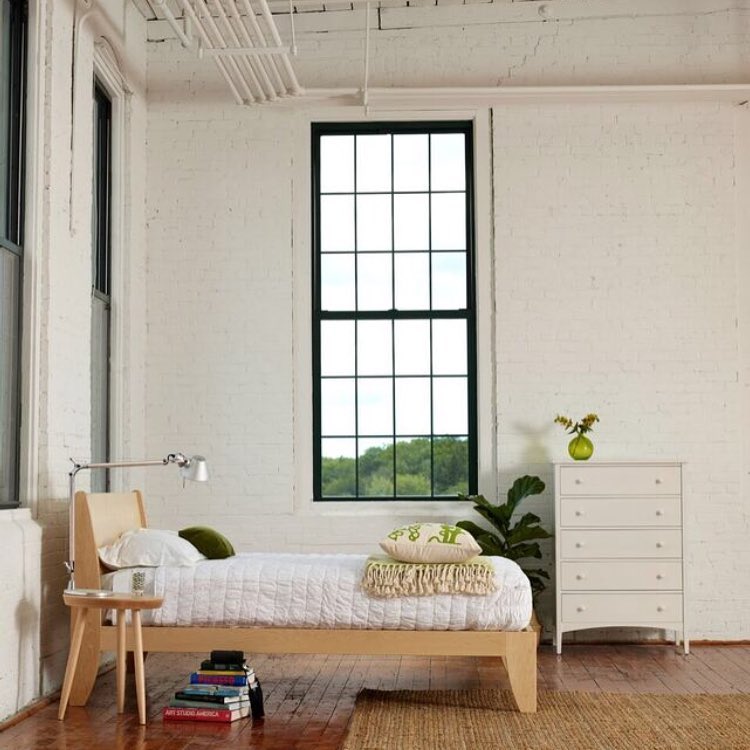
Pros
Cons
8 | Pine
Pine is a softwood that comes in a range of varieties, allowing you to make your choice depending on the properties of the wood as well as your requirements. Most commonly, white pine and yellow pine tend to be employed when it comes to building various structures, including bed frames.
In general, you can expect pine to have a light or pale color, with options like off-white, cream, yellow, and brown. Some rarer pines are also a bit darker. The closed-grain structure of pine, along with its small pores, can enhance the sturdiness and durability of this wood. Pine, especially yellow pine, also has considerable strength in terms of bending and compression.
| Wood Characteristics | Pine for Bed Frame Details |
|---|---|
| Wood Type | Softwood (Pine Tree) |
| Scientific Name | Pinus spp. (Pinus strobus, Pinus radiata, etc.) |
| Wood Grain | Straight, with a medium to coarse texture |
| Wood Density (lb/ft³, N/m³) | 25-30 lb/ft³ (400-480 kg/m³) |
| Wood Janka Scale | 690 lbf (pound-force) |
| Wood Stability | Moderate stability, susceptible to warping and shrinking if not properly dried |
| Wood Finish | Accepts stains and finishes well; also suitable for painting |
| Wood Sustainability | Generally available from sustainably managed forests; look for FSC certification |
| Wood Cost | Inexpensive compared to hardwoods |
| Moisture Content | 6-8% (kiln-dried) |
| Shrinkage | R: 4.0%, T: 7.7%, V: 11.7%, T/R Ratio: 1.93 |
| Average Dried Weight (lb/ft³, kg/m³) | 25-30 lbs/ft³ (400-480 kg/m³) |
| Build vs Buy Cost | |
| DIY Bed Frame Cost | $200 – $500 (varies depending on materials, tools, and design complexity) |
| Store-Bought Cost | $400 – $1,500 (varies depending on brand, materials, and design) |
Pine: Mini-Summary & Ideal Bed Frame Type
- Ideal Bed Frame Type: Pine is well-suited for rustic and country-style bed frames, as well as simple, minimalist designs that showcase its natural knots and warm color tones.
- Finishing Options: Pine accepts various finishes, including stains, paints, and clear coats, which allows for a versatile range of looks, from natural to more vibrant colors.
- Features & Benefits: Pine is a lightweight and affordable softwood with a moderate density, making it easy to work with for DIY projects and providing a cost-effective option for bed frames.
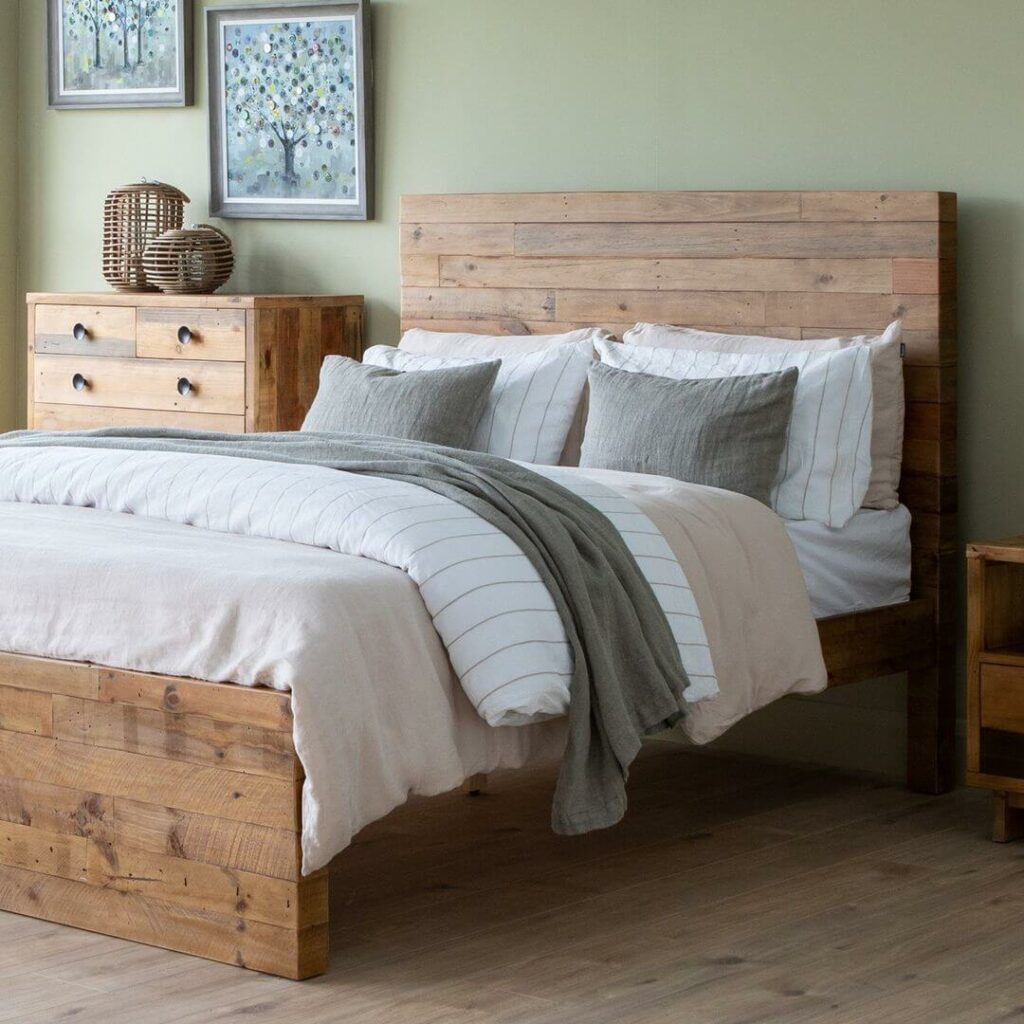
Pros
Cons
9 | Alder
Alder is a hardwood but has a relatively low density and hardness, measuring around 500-700 lbf, although several varieties measure a bit more too. This hardwood is a strong and long-lasting option that you can consider for your bed frame, offering diversity in terms of its color and grain structure.
The colors of this kind of wood usually include light brown, tan, red and dark brown, with the color being pale at first but eventually darkening with time and age. The grain is either straight or wavy, resulting in unique textures. Due to its softness, alder is convenient to cut and shape while also being responsive to stain, paint and seal.
| Wood Characteristics | Alder for Bed Frame Details |
|---|---|
| Wood Type | Hardwood (Alder Tree) |
| Scientific Name | Alnus spp. (Alnus rubra, Alnus glutinosa, etc.) |
| Wood Grain | Straight, with a fine to medium texture |
| Wood Density (lb/ft³, N/m³) | 28 lb/ft³ (450 kg/m³) |
| Wood Janka Scale | 590 lbf (pound-force) |
| Wood Stability | Good stability, with low susceptibility to warping and shrinking |
| Wood Finish | Accepts stains and finishes well; also suitable for painting |
| Wood Sustainability | Generally available from sustainably managed forests; look for FSC certification |
| Wood Cost | Moderate cost compared to other hardwoods |
| Moisture Content | 6-8% (kiln-dried) |
| Shrinkage | R: 4.4%, T: 7.4%, V: 11.8%, T/R Ratio: 1.68 |
| Average Dried Weight (lb/ft³, kg/m³) | 28 lbs/ft³ (450 kg/m³) |
| Build vs Buy Cost | |
| DIY Bed Frame Cost | $300 – $700 (varies depending on materials, tools, and design complexity) |
| Store-Bought Cost | $600 – $1,800 (varies depending on brand, materials, and design) |
Alder: Mini-Summary & Ideal Bed Frame Type
- Ideal Bed Frame Type: Alder is suitable for a wide range of bed frame styles, from traditional to contemporary, due to its fine grain and even texture that allows for intricate carving and detailing.
- Finishing Options: Alder takes stains and finishes well, making it possible to achieve various looks, including mimicking more expensive hardwoods like cherry or mahogany, or opting for a natural finish to showcase its warm color.
- Features & Benefits: As a moderately priced hardwood, alder balances affordability and durability, providing a sturdy and long-lasting option for bed frames without breaking the bank.
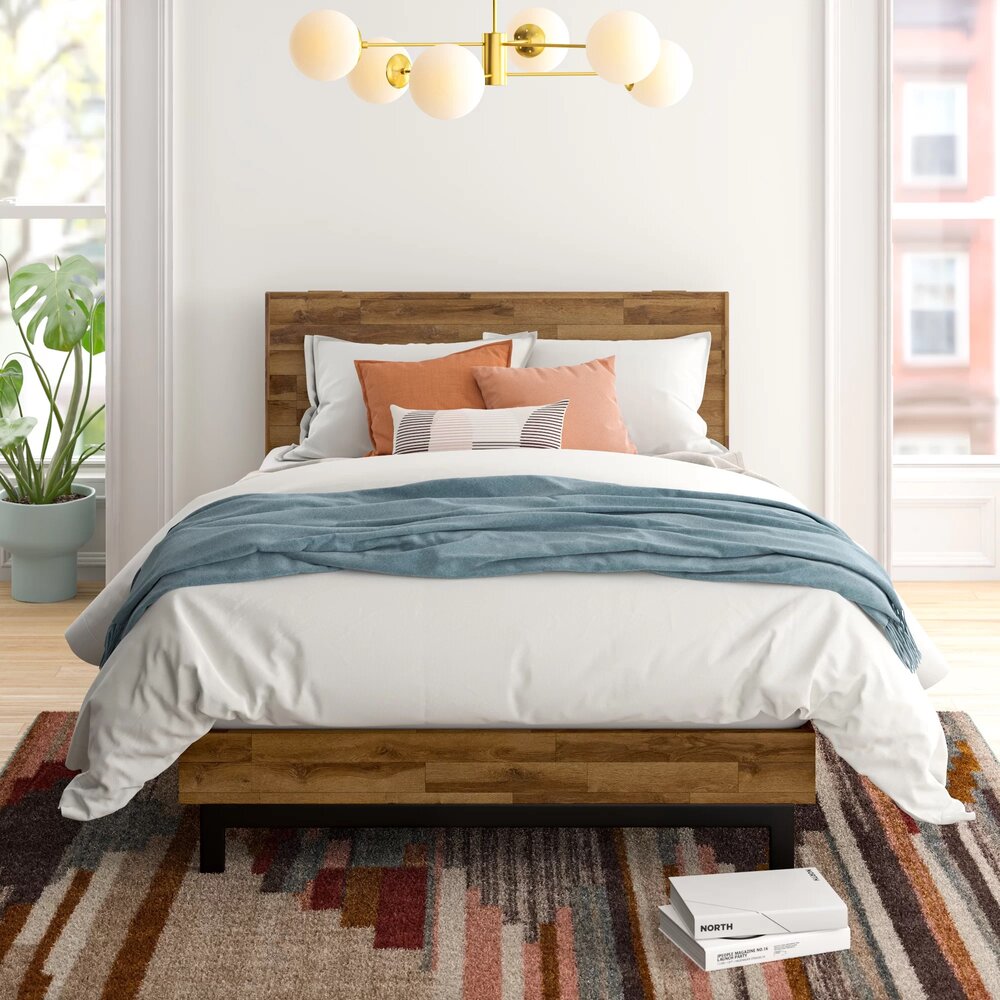
Pros
Cons
10 | Cherry
The final kind of wood on this list is cherry, which gets its name from the American Black Cherry Tree (prunus serotina). This is a hardwood that measures 950 lbf on the Janka scale, making it an extremely reliable, sturdy, and resilient kind of wood for your bed frame.
Cherry has a fine texture with interlocked grains, resulting in attractive patterns like wavy, mottled, and quilted, among others. Moreover, it has a color that ranges from light golden to a more prosperous and deeper red-brown, with tendencies to darken with time. Cherry is also quite lustrous and has large pores throughout its grain structure.
| Wood Characteristics | Cherry for Bed Frame Details |
|---|---|
| Wood Type | Hardwood (Cherry Tree) |
| Scientific Name | Prunus serotina |
| Wood Grain | Fine, closed-grain, with a smooth texture and a distinctive pattern |
| Wood Density (lb/ft³, N/m³) | 35 lb/ft³ (560 kg/m³) |
| Wood Janka Scale | 950 lbf (pound-force) |
| Wood Stability | Good stability, with low susceptibility to warping and shrinking |
| Wood Finish | Takes stains and finishes well; tends to darken with age |
| Wood Sustainability | Generally available from sustainably managed forests; look for FSC certification |
| Wood Cost | Moderate to high cost compared to other hardwoods |
| Moisture Content | 6-8% (kiln-dried) |
| Shrinkage | R: 3.7%, T: 7.1%, V: 10.8%, T/R Ratio: 1.92 |
| Average Dried Weight (lb/ft³, kg/m³) | 35 lbs/ft³ (560 kg/m³) |
| Build vs Buy Cost | |
| DIY Bed Frame Cost | $400 – $900 (varies depending on materials, tools, and design complexity) |
| Store-Bought Cost | $800 – $3,000 (varies depending on brand, materials, and design) |
Cherry: Mini-Summary & Ideal Bed Frame Type
- Ideal Bed Frame Type: Cherry wood is perfect for elegant and sophisticated bed frame designs, showcasing its rich reddish-brown color and fine, straight grain, making it popular for high-end furniture.
- Finishing Options: Cherry wood takes finishes exceptionally well, allowing for a wide range of stain colors or a clear finish that highlights its natural beauty and deepens over time due to its photosensitivity.
- Features & Benefits: Cherry wood is prized for its durability, strength, and resistance to warping and shrinking, making it an excellent investment for a durable, high-quality bed frame.
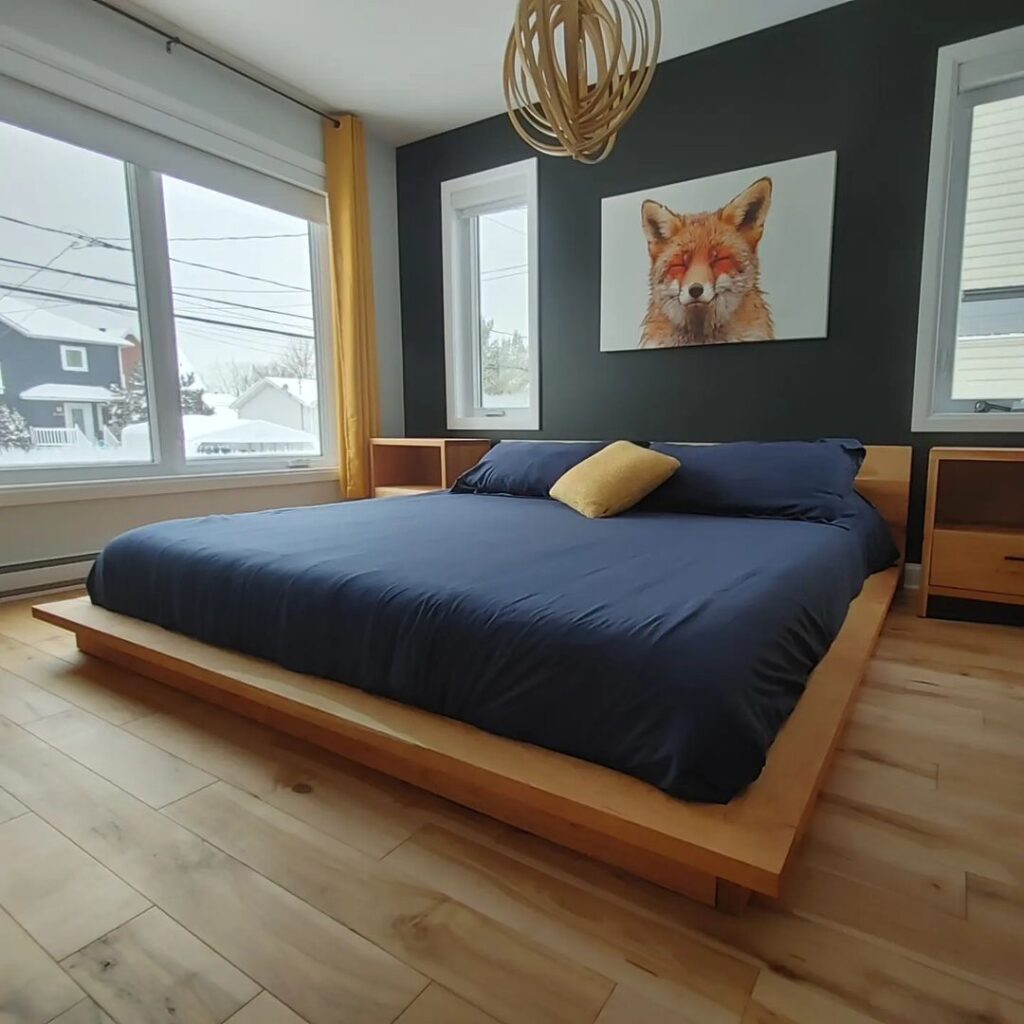
Pros
Cons
Best Wooden Bed Frames to Buy Online
So, now you know about the best kinds of wood for bed frames. How do these actually translate to real products? How do they look like, and how will they perform during usage?
To figure these out, here are some wonderful recommendations for wooden bed frames that you can buy online. You can also go through their advantages and disadvantages for a fairer and more realistic idea.
1 | Thuma Upcycled Wood Bed Frame
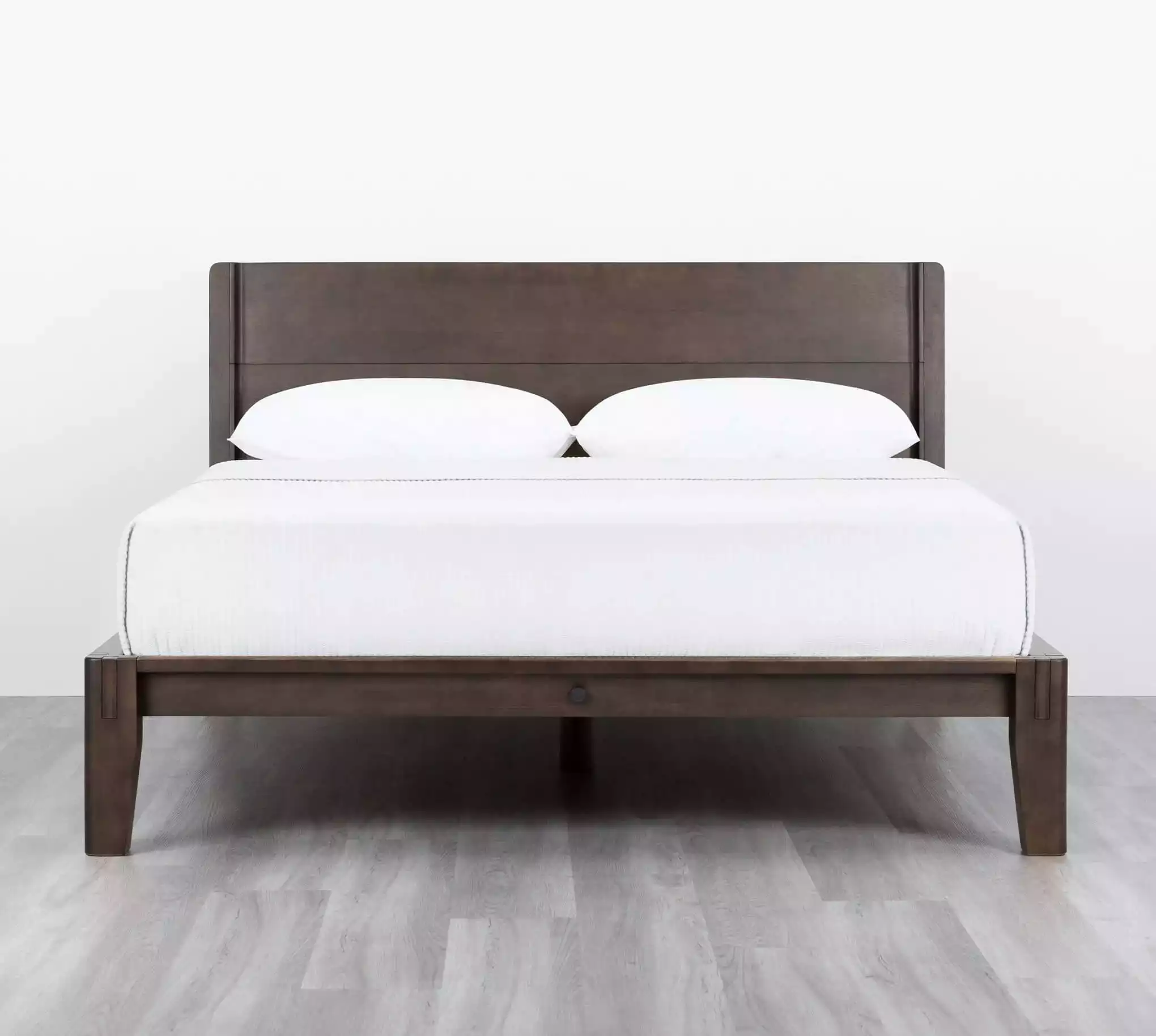 The Bed – Thuma
The Bed – Thuma
- Customizable Design: Thuma's platform bed frame, "The Bed," offers a luxurious experience with a choice of pillowboard or headboard, and three color options: Walnut, Natural, and Espresso.
- Included Parts: The Thuma bed frame package includes the frame, boards, and cushion-coated slats that make the bed stronger, more stable, and more comfortable.
- Innovative Japanese Technique: The bed frame uses a reliable Japanese joinery technique to make a simple, balanced, and aesthetically pleasing design that goes with any bedroom decor.
- Functional and Safe Design: Thuma's bed frame is designed for quiet performance and features rounded corners for safety, making it an attractive and functional addition to your bedroom.
- Slats from recycled, sustainable materials
- Easy setup, no extra tools needed
- Nine-inch under-bed storage space
- Expensive, yet high quality
- Quite heavy, difficult to move
2 | Silk & Snow Acacia Wood Bed Frame
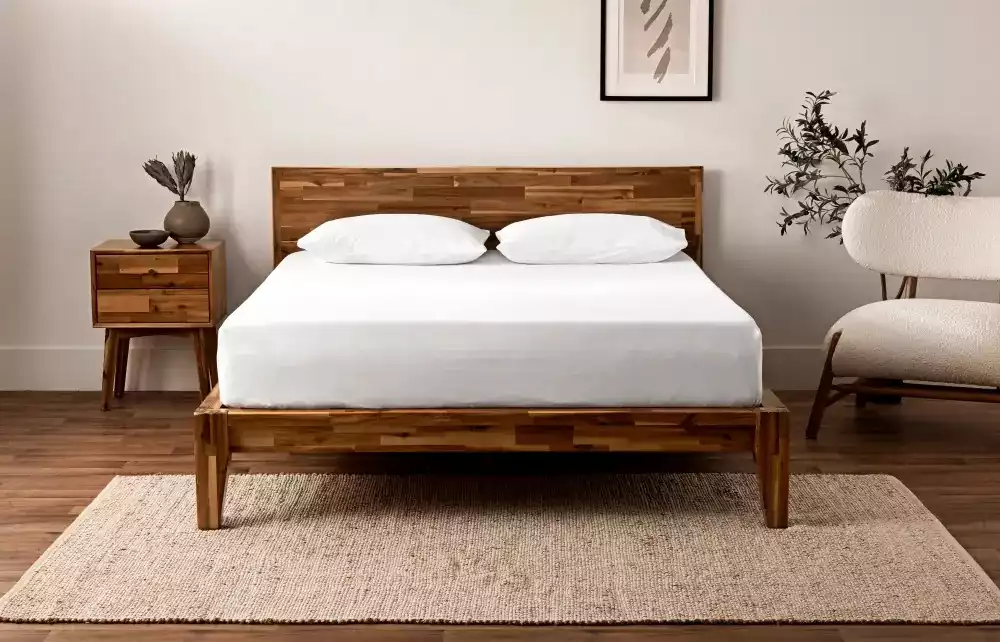 Wooden Bed Frame - Silk & Snow
Wooden Bed Frame - Silk & Snow
- Rich Acacia Wood Construction: Silk & Snow bed frame features solid acacia wood, providing a contemporary look with its dark color and unique grain patterns.
- Sturdy and Stable Design: Using Japanese joinery techniques, the bed frame offers exceptional sturdiness and stability for long-lasting use.
- Variety of Options: Choose between a platform bed or a bed frame with a headboard, available in Twin, King, Queen, and Full sizes.
- Eco-Friendly Choice: Ethically sourced and sustainable acacia wood ensures an environmentally friendly product for your bedroom.
- Quick assembly, no tools required
- 1100 lb weight capacity ensures stability
- Scratch-resistant, very durable wood
- Some rare cases of uneven slats
- Reports of possible initial squeaking
3 | Nectar Aurora Walnut Wood Bed Frame
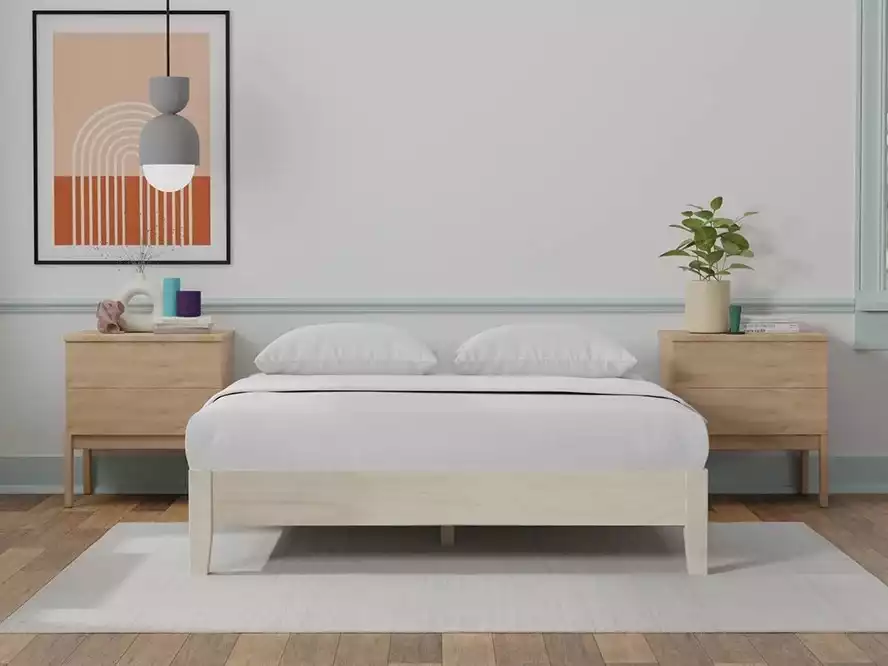 Aurora Bed Frame - Nectarsleep
Aurora Bed Frame - Nectarsleep
- Solid Construction and Size Options: The Nectar Aurora Bed Frame combines natural pine wood and reinforced steel, offering Full, King, and Queen sizes.
- Finish Options and Storage: Available in Natural and Walnut finishes, this platform design provides a low profile and under-bed storage space.
- Strength and Durability: Constructed from solid wood, the frame is built to last, making it ideal for homeowners seeking a long-lasting bed frame.
- Comfort and Easy Assembly: Designed for comfort, the frame minimizes motion transfer and noise; assembly is hassle-free with clear instructions and included hardware.
- Offers 50-night home trial for testing
- Durable wood resists decay and moisture
- Assembly tools included in the purchase
- Assembly can be difficult & time-consuming
- Wood prone to dents, scratches, cuts
4 | Casper Repose Solid Oak Bed Frame
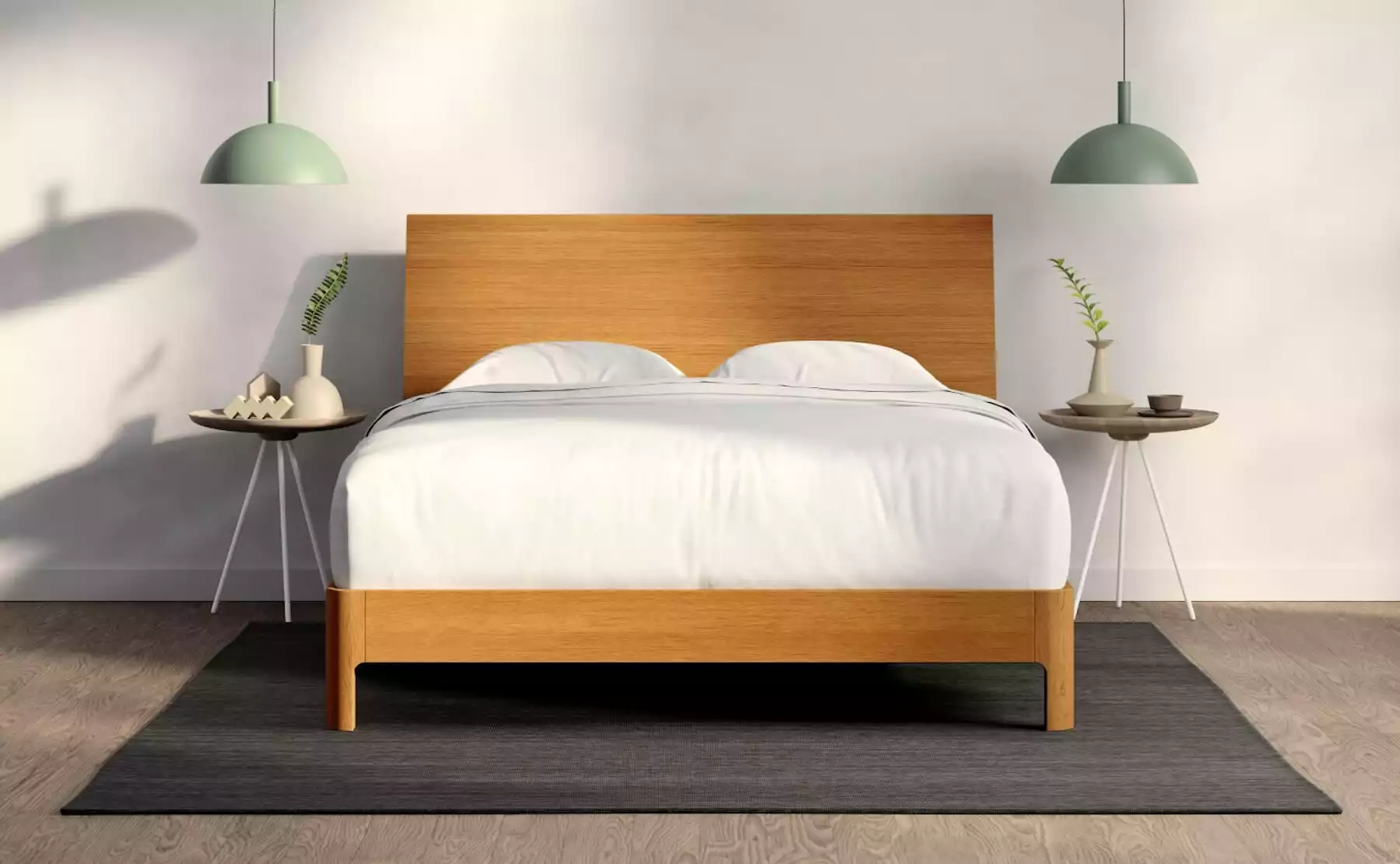 Repose Bed Frame - Casper
Repose Bed Frame - Casper
- Sturdy and Durable Construction: The Casper Repose Solid Oak Bed Frame boasts a high degree of sturdiness due to the hardness level of the wood, with soft rounded edges for safety and aesthetics, providing lasting durability.
- Design Options and Color Varieties: This bed frame offers a wooden frame for the headboard, with options to buy the frame alone or with a pillowed headboard. Choose from soft pink, light gray, or navy tweed to match your room.
- Classic, Timeless Design: The Casper Repose Solid Oak Bed Frame features a classic, timeless design that complements a variety of decor styles. It's available in multiple finishes, allowing customization for your bedroom.
- Easy Assembly and Quality Materials: This bed frame is easy to assemble, making it a convenient choice for quick setup. It's made of high-quality materials with a sturdy construction, providing a stable foundation for your mattress.
- Sustainable, premium wood ensures stability
- Low-profile frame allows accessibility, storage
- Minimal warping risk due to thickness
- Bed frame is heavy due to wood density
- Assembly time is lengthy; nuts & bolts
5 | Avocado Douglas Fir Handcraft Bed Frame
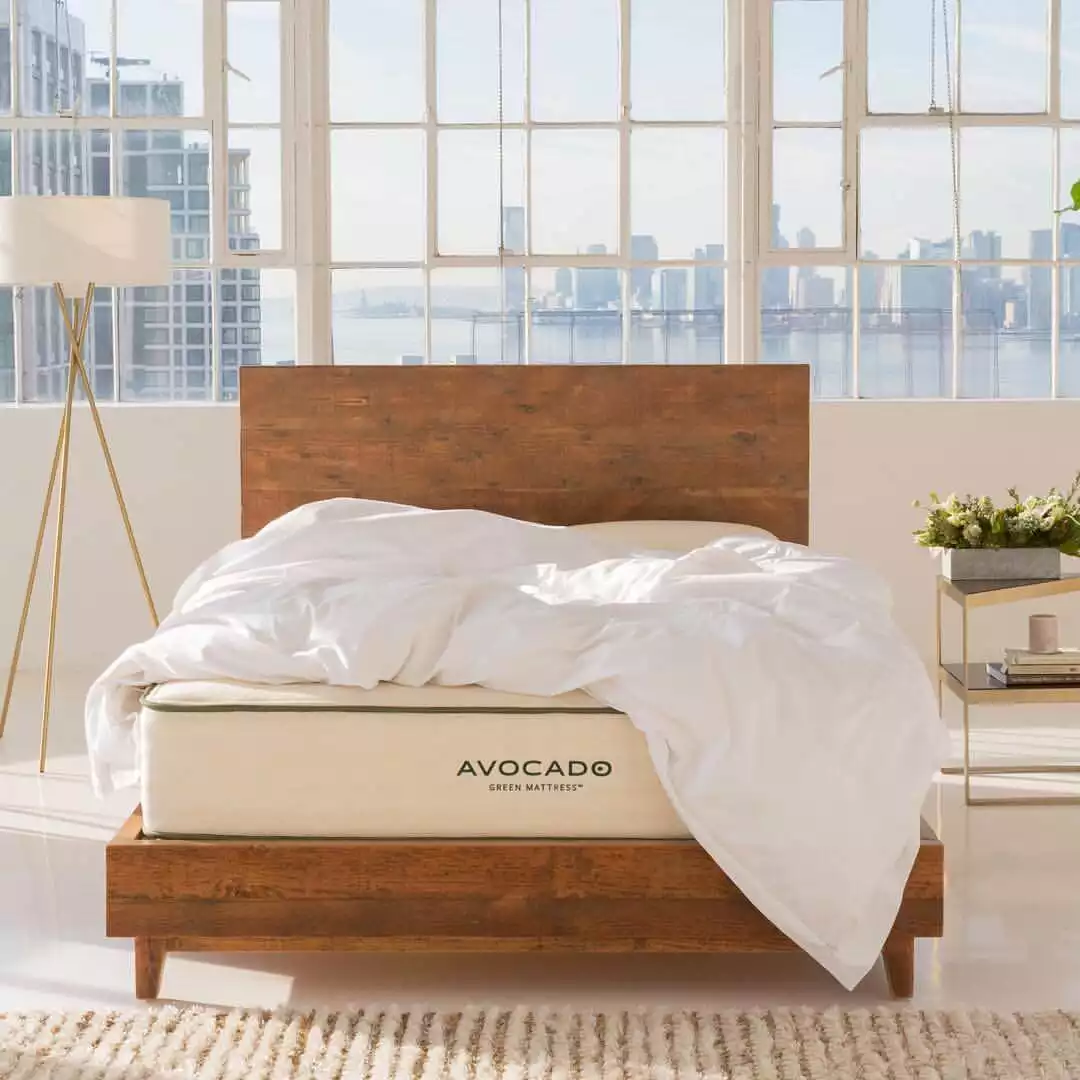 Natural Bed Frame - Avocado
Natural Bed Frame - Avocado
- Reclaimed Douglas Fir Construction: This bed is handcrafted using natural, reclaimed Douglas fir, resulting in a dependable, beautiful structure that showcases the wood's unique characteristics.
- Wide Range of Sizes: Offering various size options, including Twin, Full, King, Queen, Twin XL, and California King, this bed frame accommodates different room sizes and preferences.
- Rustic Aesthetic: The bed frame features a rustic dark color and raw stain, preserving the frame's appearance and adding a charming, timeless touch to your bedroom.
- Sturdy Slats: The bed frame's slats are constructed uniformly with pine material, enhancing the overall sturdiness and durability of the bed, ensuring long-lasting use.
- Tool-free assembly for this bed frame
- Sustainable attractive reclaimed wood
- Headboard supports back even sitting
- Expensive, heavy - not suitable for renters
- Some gaps & dents due to reclaimed wood
6 | Valyou Ash Dark Wood Bed Frame
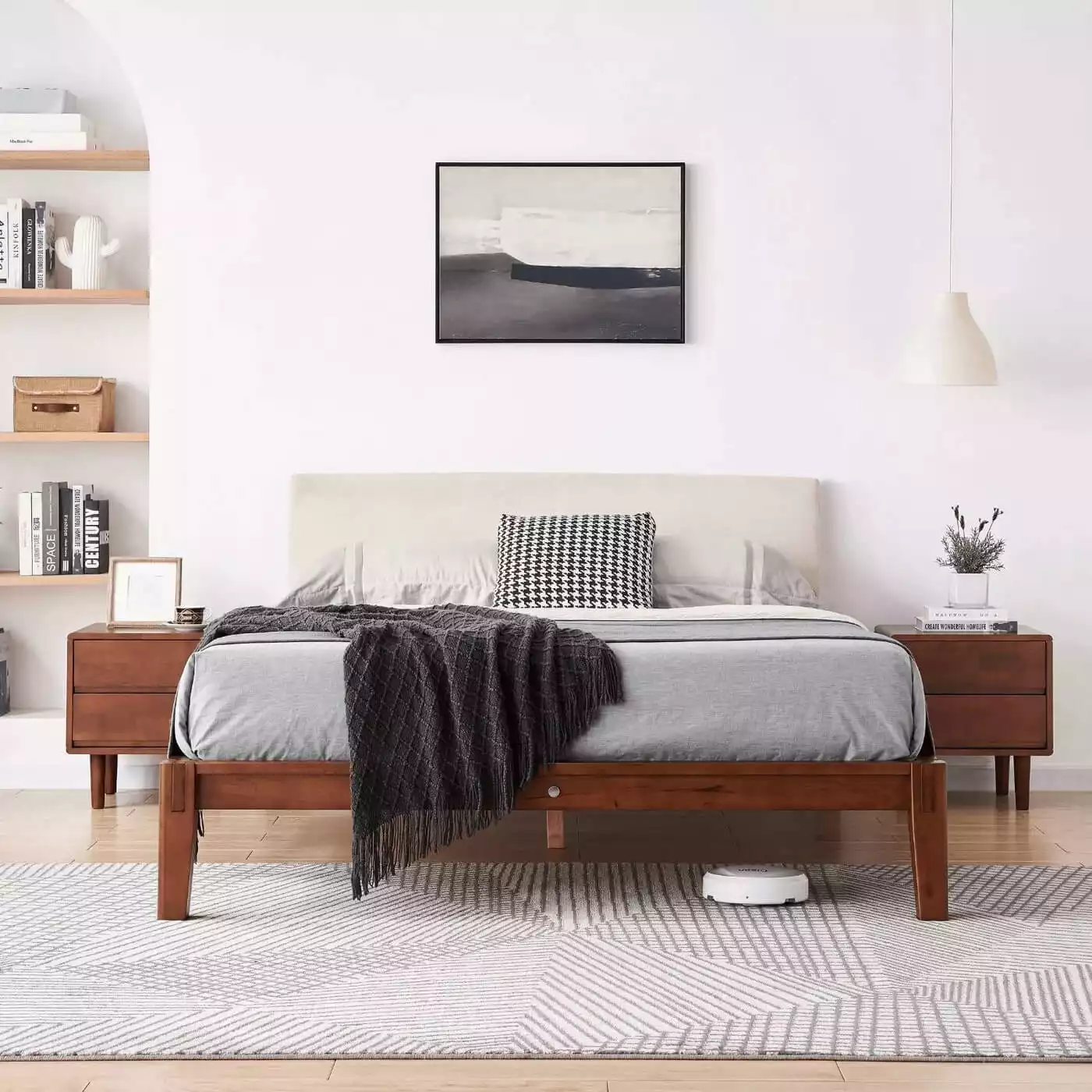 The Charm 2.0 Bed - Valyou
The Charm 2.0 Bed - Valyou
- Sturdy Ash Wood Construction: The Valyou Ash Dark Wood Bed Frame is crafted from high-quality, solid ash wood, known for its durability and strength, ensuring a long-lasting bed frame.
- Sleek, Modern Design: Featuring a sophisticated dark wood finish, this bed frame offers a contemporary design that complements various decor styles, adding warmth and elegance to any bedroom.
- Comfort and Support: Designed for comfort, the bed frame features a sturdy slatted base that provides excellent support and mattress ventilation, promoting a restful night's sleep.
- Easy Assembly: With clear instructions and all necessary hardware included, the Valyou Ash Dark Wood Bed Frame is a convenient option for those who want a quick and hassle-free setup.
- Simple, tool-free assembly takes 30 mins
- Super sturdy frame holds 1,200 lbs
- Durable solid wood resists scratches
- Headboard potentially stainable fabric
- Delay in product delivery may occur
7 | Tuft & Needle Walnut Wood Frame
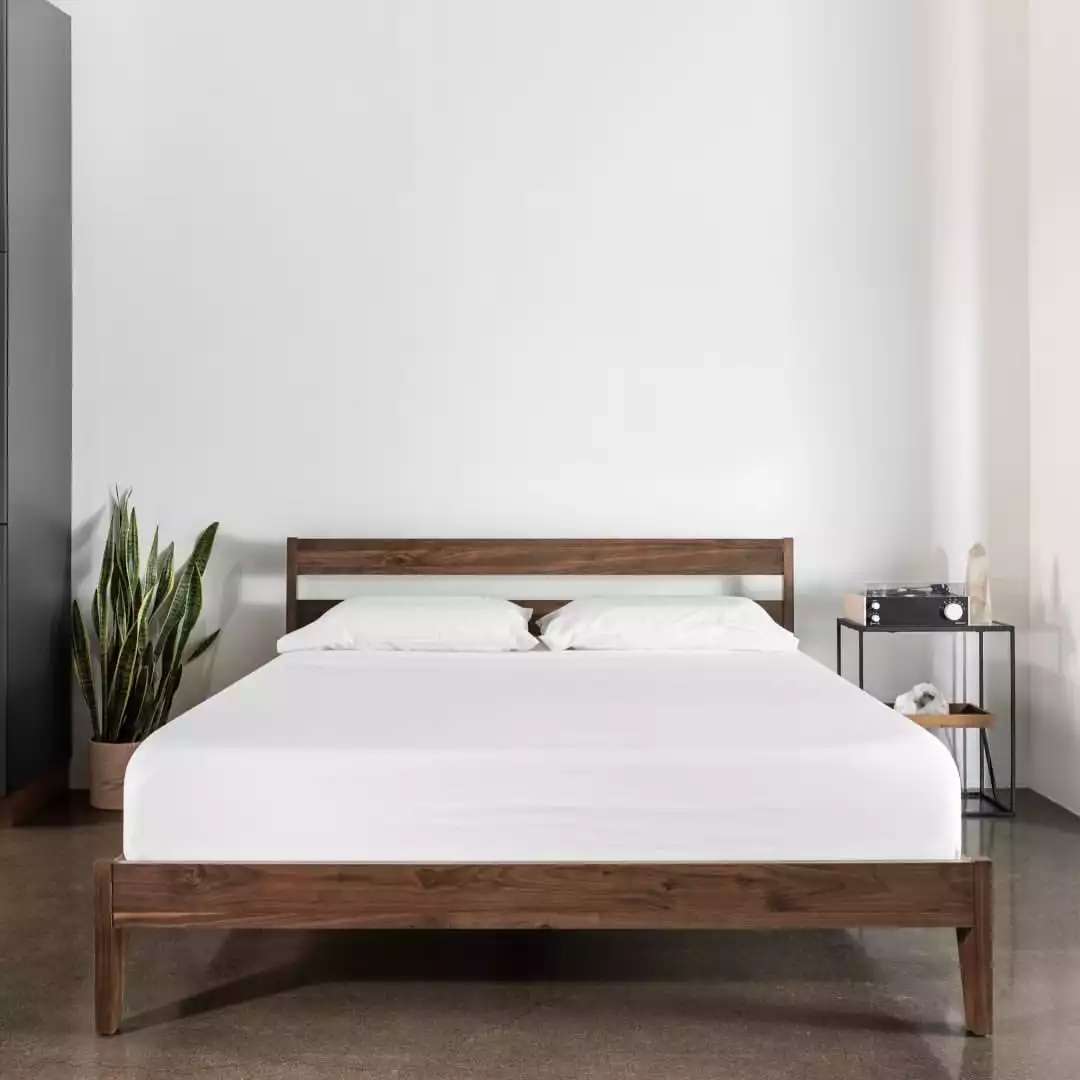 Wood Frame - Tuft & Needle
Wood Frame - Tuft & Needle
- High-Quality Walnut Construction: The Tuft & Needle Walnut Wood Frame is crafted from durable and robust walnut wood, offering reliable support and longevity for your mattress.
- Contemporary Design: With its sleek, modern design and deep brown color, this bed frame complements a variety of bedroom decor styles, adding a stylish and sophisticated touch to any space.
- Effortless Assembly: The Tuft & Needle Walnut Wood Frame is easy to assemble, providing a convenient option for quick setup, complete with all necessary hardware and clear instructions.
- Supportive and Sturdy: Designed for optimal mattress support, this bed frame features a solid construction and wooden slats, ensuring a comfortable and restful night's sleep for the long term.
- High-quality moisture-resistant wood
- 100-night sleep trial with return option
- Easy to clean with modern design
- Lengthy, tedious assembly process
- Expensive wooden bed frame option
8 | Zinus Linda Wood Platform Bed Frame
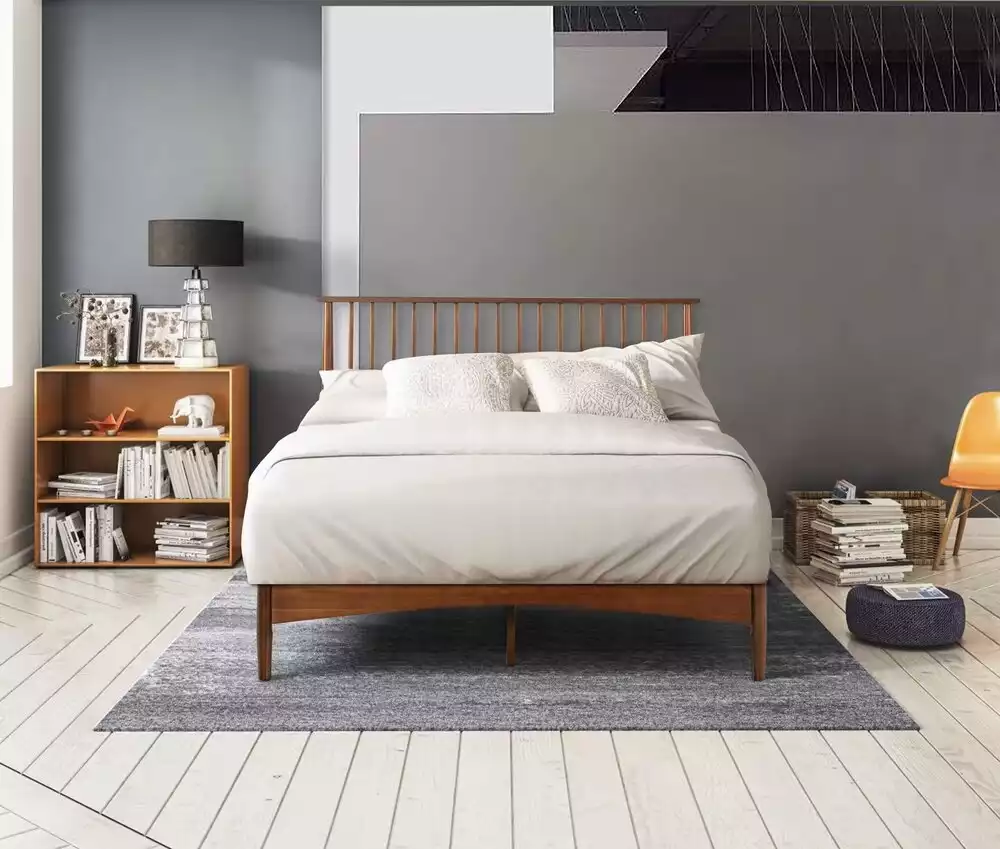 Linda Bed Frame - Zinus
Linda Bed Frame - Zinus
- Antique Charm & Durability: The Zinus Linda Wood Platform Bed Frame combines solid wood construction and a distinct mid-century design, offering antique charm and long-lasting stability for your bedroom.
- Modern Design: With its tapered legs, spindle headboard, and unique curves, this platform bed frame complements various bedroom styles, providing a stylish and functional addition to any space.
- No Box Spring Needed: Designed for use without a box spring, the Zinus Linda Wood Platform Bed Frame saves you money while offering ample support for your mattress.
- Easy Assembly: The bed frame includes clear instructions and all necessary hardware, ensuring a quick and hassle-free setup for those seeking convenience and ease of assembly.
- Unique design enhances room appearance
- Affordable, lightweight option for renters
- Curved edges prevent potential injuries
- Two-person assembly takes an hour
- Basic headboard without upholstery
Best Wood Bed Frame FAQ.
How to Choose the Right Wood for a Bed Frame?
When choosing the ideal wood for a bed frame, it’s essential to consider factors such as density, weight, noise levels, size, resistance, cost, durability, and workability.
By evaluating these aspects, you’ll be able to make an informed decision and select the best wood type for your needs.
Hardwood vs. Softwood:
Generally, hardwoods tend to be the superior choice for bed frames due to their strength, durability, and resistance to wear and tear. However, some softwoods also possess desirable qualities that make them suitable candidates for bed frames.
To make the most informed decision, consider the following key factors:
- Density and Weight: Opt for a wood type that offers the right balance between density and weight to ensure a strong, stable, and long-lasting bed frame without being overly heavy and difficult to move.
- Noise Levels: Choose a wood species that minimize creaking and other sounds, ensuring a peaceful, undisturbed sleep environment.
- Size and Resistance: Consider the dimensions and resistance levels of the wood, as these factors will determine the overall stability and longevity of your bed frame.
- Cost and Durability: Balance the cost of the wood with its durability to ensure you’re investing in a long-lasting and cost-effective solution for your bed frame.
- Workability: Select a wood type that is easy to work with and can be crafted into various designs and styles to suit your bedroom’s aesthetics.
By taking all these factors into account, you’ll be able to choose the perfect wood for your bed frame, creating a comfortable and lasting sleeping space tailored to your needs.
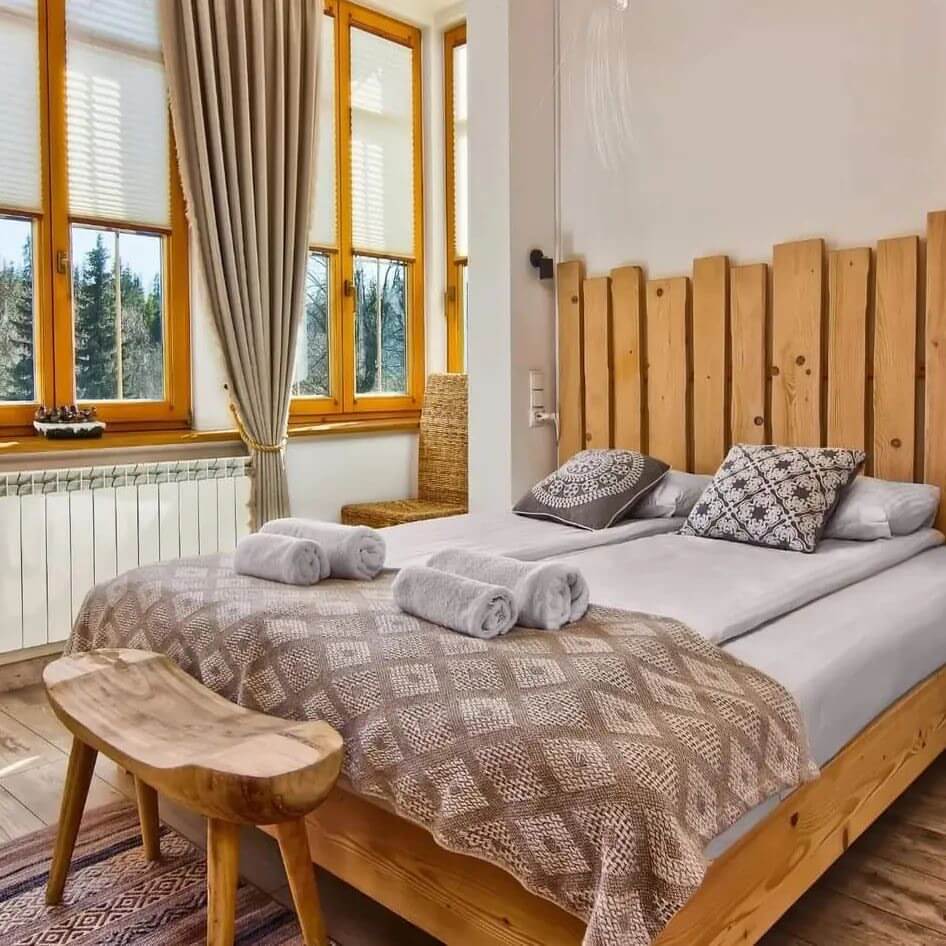
Is Building a Bed Frame Cheaper than Buying One?
When it comes to determining whether building a bed frame is more economical than purchasing one, there are several factors to consider.
While constructing a bed frame can often be less expensive due to the lower cost of raw materials, it’s essential to weigh the advantages and disadvantages of both options to make an informed decision.
Cost Considerations:
Constructing a bed frame typically requires a smaller financial investment compared to buying one, as the expenses associated with lumber and other essential materials can range from around a hundred dollars to several hundred dollars, depending on the quality of the wood used. In contrast, purchasing a pre-made bed frame can set you back over $1,000, depending on the brand, materials, and design.
Time and Effort:
However, it’s crucial to consider the time and effort required to build a bed frame from scratch. While buying a bed frame can save you the labor and time involved in constructing one, you may sacrifice some level of customization and personalization.
Making an Informed Decision:
Ultimately, determining whether building a bed frame is more cost-effective than buying one depends on your specific needs, preferences, and resources. If you have the time, skills, and desire to create a customized and unique piece of furniture, constructing a bed frame may be the more affordable option.
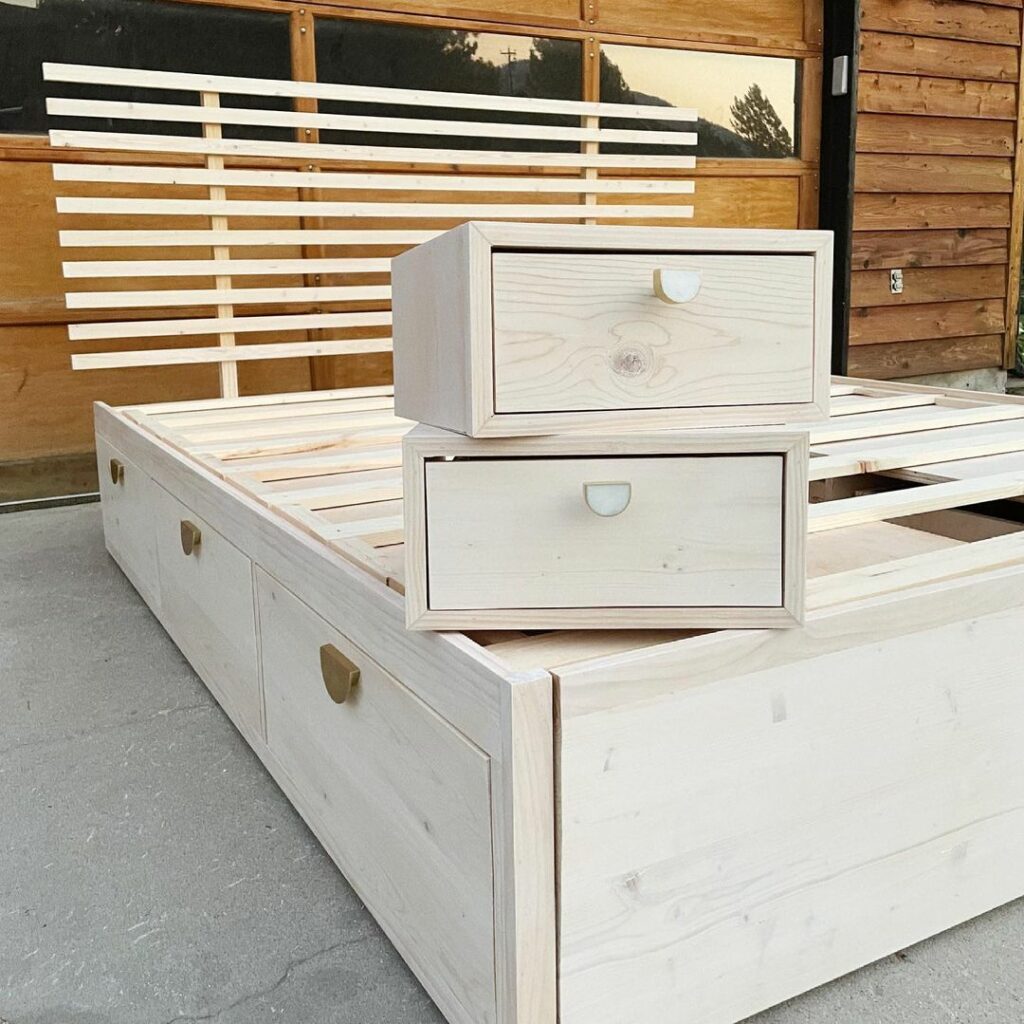
Where to Buy Lumber for Wood Bed Frames?
When it comes to purchasing lumber for constructing a wood bed frame, you have various options at your disposal. Identifying the most reputable suppliers and understanding your specific needs will ensure that you obtain high-quality wood for your project.
Local Lumber Suppliers and Home Improvement Stores:
Exploring local lumber suppliers, yards, and home improvement stores is an excellent place to start your search for the perfect wood. These establishments typically offer a range of wood types, sizes, and grades to suit various applications, including bed frame construction.
Online Retailer Stores:
In addition to local sources, numerous online retailers specialize in providing lumber for woodworking projects. When shopping online, it’s crucial to verify the legitimacy of the seller by checking customer reviews and asking for recommendations from fellow woodworkers. Make sure to inquire about shipping costs and return policies to ensure a smooth transaction.
Reclaimed Lumber:
Another eco-friendly and cost-effective option is to consider secondhand or reclaimed lumber. Sourced from deconstructed buildings, reclaimed wood offers unique character and history, while also reducing the demand for new wood resources. Check local salvage yards, architectural antiques stores, or online marketplaces for available reclaimed wood options.
The Bottom Line
Finding suitable a type of lumber for your wood bed frame requires research, diligence, and an understanding of your project’s specific needs. You can identify the best options to suit your preferences and budget by exploring various sources, both locally and online.
Key Takeaways:
Now that you are aware of the best wood for bed frames as well as the best readymade frames that you can buy online. You can narrow down this list even further and consider what works well for you and your DIY woodworking project.

